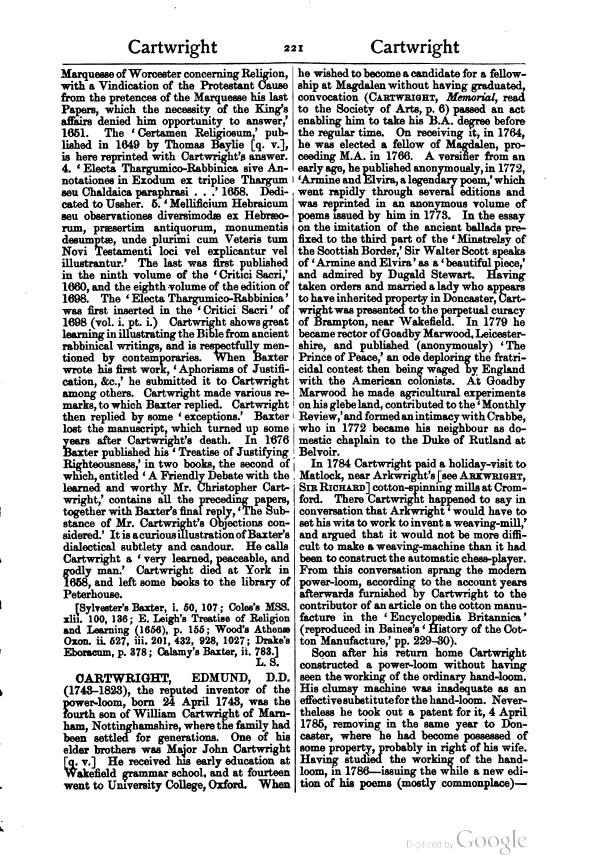- Marquesse of Worcester concerning Revelation, with a Vindication of the Protestant Cause from the pretences of the Marquesse his last Papers, which the necessity of the King's affairs denied him opportunity to answer,' 1651. The 'Certamen Religiosum,' published in 1649 by Thomas Baylie [q. v.] is here reprinted with Cartwright's answer.
- 'Electa Thargumico-Rabbinica sive Annotationes in Exodum ex triplice Thargum seu Chaldaica paraphrase …' 1658. Dedicated to Ussher.
- 'Mellificium Hebraicum seu observationes diversimodae ex Hebraeorum, praesertim antiquorum, monumentis desumptse, unde plurimi cum Veteri cum Novi Testamenti loci vel explicantur vel illustrantur.'
The last was first published in the ninth volume of the 'Critici Sacri,' 1660, and the eighth volume of the edition of 1698. The 'Electa Thargumico-Rabbinica' was first inserted in the 'Critici Sacri' of 1698 (vol. i. pt. i.) Cartwright shows great learning in illustrating the Bible from ancient rabbinical writings, and is respectfully menttioned by contemporaries. When Baxter wrote his first work, 'Aphorisms of Justification, &c.,' he submitted it to Cartwright among others. Cartwright made various remarks, to which Baxter replied. Cartwright then replied by some 'exceptions.'." Baxter lost the manuscript, which turned up some years after Cartwright's death. In 1676 Baxter published his 'Treatise of Justifying Righteousness,' in two books, the second of which, entitled 'A Friendly Debate with the learned and worthy Mr. Christopher Cartwright,' contains all the preceding papers, together with Baxter's final reply. 'The Substance of Mr. Cartwright's Objections considered.' It is a curious illustration of Baxter's dialectical subtlety and candour. He calls Cartwright a 'very learned, peaceable and godly man.' Cartwright died at York in 1658, and left some books to the library of Peterhouse.
[Sylvester's Baxter, i. 50. 107; Coles's MSS. xlii. 100, 136; E. Leigh's Treatise of Religion and Learning (1656), p. 155; Wood's Athenae Oxon. ii. 527, iii. 201, 432, 928, 1027; Drake's Eboracum, p. 378; Calamy's Baxter, ii. 783.]
CARTWRIGHT, EDMUND, D.D. (1743–1823), the reputed inventor of the power-loom, born 24 April 1743, was the fourth son of William Cartwright of Marnham, Nottinghamshire, where the family had been settled for generations. One of his elder brothers was Major John Cartwright [q. v.] He received his early education at Wakefield grammar school, and at fourteen went to University College, Oxford. When he wished to become a candidate for a fellowship at Magdalen without having graduated, convocation (Cartwright, Memorial, read to the Society of Arts, p. 6) passed an act enabling him to take his B.A. degree before the regular time. On receiving it, in 1764, he was elected a fellow of Magdalen, proceeding M.A. in 1766. A versifier from an early age, he published anonymously, in 1772, ‘Armine and Elvira, a legendary poem,’ which went rapidly through several editions and was reprinted in an anonymous volume of poems issued by him in 1773. In the essay on the imitation of the ancient ballads prefixed to the third part of the ‘Minstrelsy of the Scottish Border,’ Sir Walter Scott speaks of ‘Armine and Elvira’ as a ‘beautiful piece,’ and admired by Dugald Stewart. Having taken orders and married a lady who appears to have inherited property in Doncaster, Cartwright was presented to the perpetual curacy of Brampton, near Wakefield. In 1779 he became rector of Goadby Marwood, Leicestershire, and published (anonymously) ‘The Prince of Peace,’ an ode deploring the war with the American colonists. At Goadby Marwood he made agricultural experiments on his glebe land, contributed to the ‘Monthly Review,’ and formed an intimacy with Crabbe, who in 1772 became his neighbour as chaplain to the Duke of Rutland at Belvoir. Cartwright was prebendary of Lincoln from 1786 till death.
In 1784 Cartwright paid a holiday-visit to Matlock, near Arkwright's [see Arkwright, Sir Richard] cotton-spinning mills at Cromford. There Cartwright happened to say in conversation that Arkwright ‘would have to set his wits to work to invent a weaving-mill,’ and argued that it would not be more difficult to make a weaving-machine than it had been to construct the automatic chess-player. From this conversation sprang the modern power-loom, according to the account years afterwards furnished by Cartwright to the contributor of an article on the cotton manufacture in the ‘Encyclopædia Britannica’ (reproduced in Baines's ‘History of the Cotton Manufacture,’ pp. 229–30).
Soon after his return home Cartwright constructed a power-loom without having seen the working of the ordinary hand-loom. His clumsy machine was inadequate as an effective substitute for the hand-loom. Nevertheless he took out a patent for it, 4 April 1785, removing in the same year to Doncaster, where he had become possessed of some property, probably in right of his wife. Having studied the working of the handloom, in 1786—issuing the while a new edition of his poems (mostly
